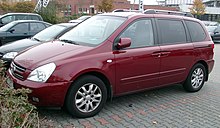DKW Schnellaster




The DKW Schnellaster ("Rapid Transporter"[1]) was a van produced by DKW from 1949 to 1962, of a monospace (or one-box) design with front wheels set forward of the passenger cabin, a short, sloping aerodynamic hood, front wheel drive, transverse engine, flat load floor throughout with flexible seating and cargo accommodations.
The Schnellaster has been considered a precursor of the modern minivan as well, a configuration later popularized in such notable examples as the Renault Espace, Chrysler Voyager/Caravan or Kia Carnival/Sedona (pictured right).[1]
The van included a trailing-arm rear suspension system incorporating springs in the cross bar assembly. The modern layout featured a prewar two-cylinder 700 cc two-stroke engine of the DKW F8 rated at 20 hp (22 hp after 1952). In 1955 the van received the DKW F9's three cylinder unit with 900 cc, producing 32 hp (24 kW).
The van's layout enabled a floor 40 cm (16 in) off the ground. It was also fitted with a large single rear door fitted to hinges on the right-hand side.
The van was also produced in Vitoria, Spain, by Industrias del Motor S.A. (IMOSA) from 1954. In Spain, DKW became a common term for any van, and is still used today. The Spanish subsidiary also produced a modern successor, introduced in 1963 and called DKW F 1000 L. This van started with the three cylinder 980 cc two-stroke DKW engine, but later received a Mercedes-Benz Diesel engine and finally was renamed a Mercedes-Benz in 1975.
In 1969 the DKW van was manufactured under licence by Industrias Automotriz de Santa Fe (IASFe) in Argentina, though for only one year, after producing the "Schnellaster" the previous 10 years, the factory had closed its doors, but Industrias Mecánicas del Estado (IME) continued its production as the Rastrojero Frontalito F 71 / SM 81 from 1969 until 1979 in pickup, minibus and van versions.
References
- ^ a b "The Mother Of All Modern Minivans: 1949 DKW Schnellaster". The Truth About Cars, Paul Niedermeyer, March 29, 2010.
